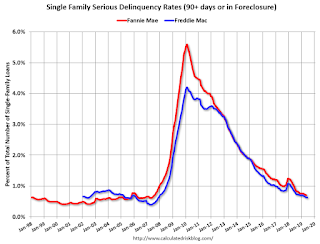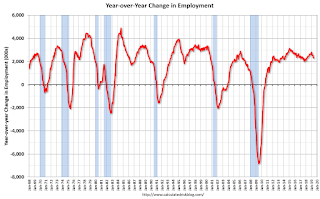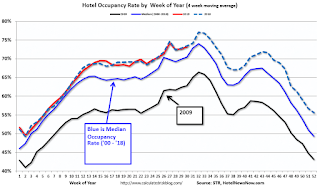by Calculated Risk on 7/29/2019 04:42:00 PM
Monday, July 29, 2019
Freddie Mac: Mortgage Serious Delinquency Rate unchanged in June
Freddie Mac reported that the Single-Family serious delinquency rate in June was 0.63%, unchanged from 0.63% in May. Freddie's rate is down from 0.82% in June 2018.
Freddie's serious delinquency rate peaked in February 2010 at 4.20%.
This equals the lowest serious delinquency rate for Freddie Mac since November 2007.
These are mortgage loans that are "three monthly payments or more past due or in foreclosure".

I expect the delinquency rate to decline to a cycle bottom in the 0.4% to 0.6% range - so this is close to a bottom.
Note: Fannie Mae will report for June soon.
FOMC Preview
by Calculated Risk on 7/29/2019 01:54:00 PM
Expectations are the FOMC will cut the Fed Funds rate 25bp at the meeting this week.
Here are some comment from Professor Tim Duy: It’s Rate Cut Week
Bottom Line: Look for 25bp from the Fed this week with a signal that they are prepared to do more but that they remain data dependent and are not committed to a specific policy path.And from Goldman Sachs chief economist Jan Hatzius:
The FOMC will almost certainly cut the funds rate on July 31. We expect a 25bp move because virtually all of the signals from the committee point that way. … Growth, employment, and inflation remain close to the Fed’s goals and the data have consistently surprised on the upside since the June FOMC meeting. Meanwhile, financial conditions are already very easy, and our new analysis of the role of credit market sentiment suggests that further easing could raise financial stability concerns down the road. For these reasons, while a September cut remains our baseline, it is far from a done deal.As Hatzius noted the data "have surprised on the upside since the June FOMC meeting". For review are the June FOMC projections.
Q1 real GDP growth was at 3.1% annualized, and Q2 at 2.1%. So far this year, growth has been above the FOMC projections.
| GDP projections of Federal Reserve Governors and Reserve Bank presidents | |||
|---|---|---|---|
| Change in Real GDP1 | 2019 | 2020 | 2021 |
| Jun 2019 | 2.0 to 2.2 | 1.8 to 2.0 | 1.8 to 2.0 |
| Mar 2019 | 1.9 to 2.2 | 1.8 to 2.0 | 1.7 to 2.0 |
The unemployment rate was at 3.7% in June. The unemployment rate projection for Q2 2019 might be a little high.
| Unemployment projections of Federal Reserve Governors and Reserve Bank presidents | |||
|---|---|---|---|
| Unemployment Rate2 | 2019 | 2020 | 2021 |
| Jun 2019 | 3.6 to 3.7 | 3.6 to 3.9 | 3.7 to 4.1 |
| Mar 2019 | 3.6 to 3.8 | 3.5 to 3.9 | 3.6 to 4.0 |
The June PCE report will be released tomorrow. As of May 2019, PCE inflation was up 1.5% from May 2018. Recent data suggests PCE inflation will increase a little.
| Inflation projections of Federal Reserve Governors and Reserve Bank presidents | |||
|---|---|---|---|
| PCE Inflation1 | 2019 | 2020 | 2021 |
| Jun 2019 | 1.5 to 1.6 | 1.9 to 2.0 | 2.0 to 2.1 |
| Mar 2019 | 1.8 to 1.9 | 2.0 to 2.1 | 2.0 to 2.1 |
PCE core inflation was up 1.6% in May year-over-year. Something to check in the report to be released tomorrow.
| Core Inflation projections of Federal Reserve Governors and Reserve Bank presidents | |||
|---|---|---|---|
| Core Inflation1 | 2019 | 2020 | 2021 |
| Jun 2019 | 1.7 to 1.8 | 1.9 to 2.0 | 2.0 to 2.1 |
| Mar 2019 | 1.9 to 2.0 | 2.0 to 2.1 | 2.0 to 2.1 |
Dallas Fed: "Texas Manufacturing Continues Moderate Expansion"
by Calculated Risk on 7/29/2019 10:36:00 AM
From the Dallas Fed: Texas Manufacturing Continues Moderate Expansion
Texas factory activity continued to expand in July, according to business executives responding to the Texas Manufacturing Outlook Survey. The production index, a key measure of state manufacturing conditions, moved from 8.9 to 9.3, indicating output growth continued at roughly the same pace as in June.This was the last of the regional Fed surveys for July.
Other measures of manufacturing activity suggested a slightly faster expansion in July. The new orders index edged up to 5.5, and the growth rate of orders index rebounded into positive territory, climbing nine points to 2.7. The capacity utilization index inched up to 11.2, and the shipments index jumped nine points to 10.2.
Perceptions of broader business conditions were less negative in July. The general business activity index rose six points but remained in negative territory for a third month in a row, coming in at -6.3. The company outlook index rose five points to -0.9, with the near-zero reading indicating that the share of firms noting a worsened outlook roughly equaled the share noting an improved outlook. The index measuring uncertainty regarding companies’ outlooks retreated 12 points from its June peak, coming in at 9.7.
Labor market measures suggested robust growth in employment and work hours in July. The employment index rose seven points to 16.0, a reading well above average. Twenty-four percent of firms noted net hiring, while 8 percent noted net layoffs. The hours worked index pushed further above average as well with a reading of 6.6.
emphasis added
Here is a graph comparing the regional Fed surveys and the ISM manufacturing index:
 Click on graph for larger image.
Click on graph for larger image.The New York and Philly Fed surveys are averaged together (yellow, through July), and five Fed surveys are averaged (blue, through July) including New York, Philly, Richmond, Dallas and Kansas City. The Institute for Supply Management (ISM) PMI (red) is through June (right axis).
The regional surveys were weak again in July, and based on these regional surveys, it seems likely the ISM manufacturing index will be weak again. The ISM survey will be released on Thursday, and the consensus is for the ISM to be at 51.9, up from 51.7 in June.
Q2 2019 GDP Details on Residential and Commercial Real Estate
by Calculated Risk on 7/29/2019 09:31:00 AM
The BEA has released the underlying details for the Q2 initial GDP report.
The BEA reported that investment in non-residential structures decreased at a 10.6% annual pace in Q2.
Investment in petroleum and natural gas exploration decreased in Q2 compared to Q2, and was down 8% year-over-year, but has increased substantially over the last two years.

The first graph shows investment in offices, malls and lodging as a percent of GDP.
Investment in offices increased in Q2, and is up 9% year-over-year.
Investment in multimerchandise shopping structures (malls) peaked in 2007 and was down about 37% year-over-year in Q1 - and at a record low as a percent of GDP. The vacancy rate for malls is still very high, so investment will probably stay low for some time.
Lodging investment increased in Q2, and lodging investment is up 6% year-over-year.

Usually single family investment is the top category, although home improvement was the top category for five consecutive years following the housing bust. Then investment in single family structures was back on top, however it is close between single family and home improvement.
Even though investment in single family structures has increased from the bottom, single family investment is still very low, and still below the bottom for previous recessions as a percent of GDP. I expect some further increases.
Investment in single family structures was $267 billion (SAAR) (about 1.3% of GDP)..
Investment in multi-family structures increased in Q2.
Investment in home improvement was at a $261 billion Seasonally Adjusted Annual Rate (SAAR) in Q2 (about 1.2% of GDP). Home improvement spending has been solid.
Sunday, July 28, 2019
Sunday Night Futures
by Calculated Risk on 7/28/2019 07:44:00 PM
Weekend:
• Schedule for Week of July 28, 2019
Monday:
• At 10:30 AM, Dallas Fed Survey of Manufacturing Activity for July. This is the last of the regional surveys for July.
From CNBC: Pre-Market Data and Bloomberg futures: S&P 500 and DOW futures are down slightly (fair value).
Oil prices were down over the last week with WTI futures at $56.04 per barrel and Brent at $63.15 barrel. A year ago, WTI was at $69, and Brent was at $75 - so oil prices are down about 15%to 20% year-over-year.
Here is a graph from Gasbuddy.com for nationwide gasoline prices. Nationally prices are at $2.72 per gallon. A year ago prices were at $2.85 per gallon, so gasoline prices are down about 5% year-over-year.
July 2019: Unofficial Problem Bank list decreased to 75 Institutions
by Calculated Risk on 7/28/2019 01:21:00 PM
Note: Surferdude808 compiles an unofficial list of Problem Banks compiled only from public sources. DISCLAIMER: This is an unofficial list, the information is from public sources and while deemed to be reliable is not guaranteed. No warranty or representation, expressed or implied, is made as to the accuracy of the information contained herein and same is subject to errors and omissions. This is not intended as investment advice. Please contact CR with any errors.
Here is the unofficial problem bank list for July 2019.
Here are the monthly changes and a few comments from surferdude808:
Update on the Unofficial Problem Bank List for July 2019. During the month, the list decreased by a net of one institution to 75 banks after two removals and one addition. Aggregate assets fell slightly to $55.4.7 billion from $55.0 billion a month earlier. A year ago, the list held 89 institutions with assets of $57.3 billion. This month, actions were terminated against The Equitable Bank, S.S.B., Wauwatosa, WI ($306 million) and Citizens Bank of Chatsworth, Chatsworth, IL ($31 million). Added this month was The First National Bank of Tahoka, Tahoka, TX ($55 million). While already on the list, the OCC issued an updated Prompt Action Directive on June 26, 2019 to City National Bank of New Jersey, Newark, NJ ($156 million).
Saturday, July 27, 2019
Schedule for Week of July 28, 2019
by Calculated Risk on 7/27/2019 08:11:00 AM
The key report this week is the July employment report.
Other key reports include Personal Income and Outlays for June, Case-Shiller house prices for May, and the Trade deficit for June.
For manufacturing, the July Dallas Fed, and the July ISM manufacturing surveys will be released.
The FOMC meets this week, and the Fed is expected to announce a 25bps cut to the Fed Funds rate.
10:30 AM: Dallas Fed Survey of Manufacturing Activity for July. This is the last of the regional surveys for July.
8:30 AM ET: Personal Income and Outlays, June 2019. The consensus is for a 0.3% increase in personal income, and for a 0.3% increase in personal spending. And for the Core PCE price index to increase 0.2%.
 9:00 AM: S&P/Case-Shiller House Price Index for May.
9:00 AM: S&P/Case-Shiller House Price Index for May.This graph shows the year-over-year change in the seasonally adjusted National Index, Composite 10 and Composite 20 indexes through the most recent report (the Composite 20 was started in January 2000).
The consensus is for a 2.6% year-over-year increase in the Comp 20 index for May.
10:00 AM: Pending Home Sales Index for June. The consensus is for a 0.3% increase in the index.
7:00 AM ET: The Mortgage Bankers Association (MBA) will release the results for the mortgage purchase applications index.
8:15 AM: The ADP Employment Report for July. This report is for private payrolls only (no government). The consensus is for 155,000 payroll jobs added in July, up from 102,000 added in June.
9:45 AM: Chicago Purchasing Managers Index for July.
2:00 PM: FOMC Meeting Announcement. The Fed is expected to announce a 25bps cut to the Fed Funds rate at this meeting.
2:30 PM: Fed Chair Jerome Powell holds a press briefing following the FOMC announcement.
8:30 AM: The initial weekly unemployment claims report will be released. The consensus is for 213 thousand initial claims, up from 206 thousand last week.
 10:00 AM: ISM Manufacturing Index for July. The consensus is for the ISM to be at 51.9, up from 51.7 in June.
10:00 AM: ISM Manufacturing Index for July. The consensus is for the ISM to be at 51.9, up from 51.7 in June.Here is a long term graph of the ISM manufacturing index.
The employment index was at 54.5 in June, and the new orders index was at 50.0%.
10:00 AM: Construction Spending for June. The consensus is for a 0.4% increase in construction spending.
 8:30 AM: Employment Report for July. The consensus is for 156,000 jobs added, and for the unemployment rate to decline to 3.6%.
8:30 AM: Employment Report for July. The consensus is for 156,000 jobs added, and for the unemployment rate to decline to 3.6%.There were 224,000 jobs added in June, and the unemployment rate was at 3.7%.
This graph shows the year-over-year change in total non-farm employment since 1968.
In June, the year-over-year change was 2.301 million jobs.
 8:30 AM: Trade Balance report for June from the Census Bureau.
8:30 AM: Trade Balance report for June from the Census Bureau. This graph shows the U.S. trade deficit, with and without petroleum, through the most recent report. The blue line is the total deficit, and the black line is the petroleum deficit, and the red line is the trade deficit ex-petroleum products.
The consensus is the trade deficit to be $54.7 billion. The U.S. trade deficit was at $55.5 Billion the previous month.
10:00 AM: University of Michigan's Consumer sentiment index (Final for July). The consensus is for a reading of 98.4.
Friday, July 26, 2019
Hotels: Occupancy Rate Decreased Year-over-year
by Calculated Risk on 7/26/2019 05:05:00 PM
From HotelNewsNow.com: STR: US hotel results for week ending 20 July
The U.S. hotel industry reported mixed year-over-year results in the three key performance metrics during the week of 14-20 July 2019, according to data from STR.The following graph shows the seasonal pattern for the hotel occupancy rate using the four week average.
In comparison with the week of 15-21 July 2018, the industry recorded the following:
• Occupancy: -0.5% to 77.9%
• Average daily rate (ADR): +0.5% to US$136.49
• Revenue per available room (RevPAR): flat at US$106.34
emphasis added
 Click on graph for larger image.
Click on graph for larger image.The red line is for 2019, dash light blue is 2018 (record year), blue is the median, and black is for 2009 (the worst year probably since the Great Depression for hotels).
Occupancy has been solid in 2019, close to-date compared to the previous 4 years.
Seasonally, the occupancy rate will now stay at a high level during the Summer travel season.
Data Source: STR, Courtesy of HotelNewsNow.com
Real GDP Annual and Quarterly
by Calculated Risk on 7/26/2019 11:44:00 AM
The following graphs show real GDP quarterly (blue, annualized), and the year-over-year change in GDP (red).
The tax changes at the end of 2017 have had minimal impact on GDP. Most forecasts showed some minor boost in 2018 and 2019 followed by a minor drag starting in 2020. With the new budget agreement, there probably will be little drag from fiscal policy next year.
Also, as shown earlier, there was no investment boom following the tax changes.
However, the tax changes did result in a large increase in the budget deficit (as predicted by all competent analysts).

This rate of growth is about what we should expect, see: Demographics and GDP: 2% is the new 4%
Q2 GDP: Investment
by Calculated Risk on 7/26/2019 08:58:00 AM
Investment was weak again in Q2, although personal consumption expenditures (PCE) was strong (increased at a 4.3% annual rate).
The first graph below shows the contribution to GDP from residential investment, equipment and software, and nonresidential structures (3 quarter trailing average). This is important to follow because residential investment tends to lead the economy, equipment and software is generally coincident, and nonresidential structure investment trails the economy.
In the graph, red is residential, green is equipment and software, and blue is investment in non-residential structures. So the usual pattern - both into and out of recessions is - red, green, blue.
The dashed gray line is the contribution from the change in private inventories.

Residential investment (RI) decreased in Q2 (-1.5% annual rate in Q2). Equipment investment increased slightly at a 0.7% annual rate, and investment in non-residential structures decreased at a 10.6% annual rate.
On a 3 quarter trailing average basis, RI (red) is down slightly, equipment (green) is slightly positive, and nonresidential structures (blue) is down slightly.
Recently RI has been soft, but the decrease is fairly small.
I'll post more on the components of non-residential investment once the supplemental data is released.

Residential Investment as a percent of GDP decreased in Q2, however RI has generally been increasing. RI as a percent of GDP is close to the bottom of the previous recessions - and I expect RI to continue to increase further in this cycle.
I'll break down Residential Investment into components after the GDP details are released.
Note: Residential investment (RI) includes new single family structures, multifamily structures, home improvement, broker's commissions, and a few minor categories.



